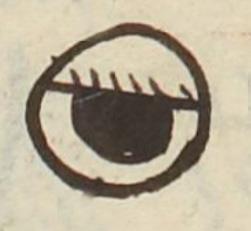Tlamauh (MH496r)
This black-line drawing of the simplex glyph for the personal name Tlamauh ("Wise One," here, attested as a man's name) shows an eye. It is similar to a starry or stellar eye of early times, but it does have a hint of added lashes, suggesting European influence in the style of painting a human eye. The eye is a circle with a simple lid coming down and covering the black center (pupil or iris). The white of the eye is somewhat lighter than the lid.
Stephanie Wood
Tlamauh (or Tlamao, as it is often spelled) is a powerful name. The style of this eye is also called the starry eye or stellar eye, given how it can double as a star in the sky. This connection with celestial phenomena may relate to the meaning of the personal name. From other examples we also see a connection with Ehecatl. The name seems to derive from tlahmati, supposedly to "practice trickery or sorcery" (very close to tlamati, to know something). However, the translation of sorcery and trickery reveals a Christian bias on the part of the friar Alonso de Molina, and really the Nahuas saw the Tlamao as being wise, perhaps like a priest or a tlamatini. Supporting this, the use of the eye (ixtli) for the glyph calls forth the verb ixtlamati, to be wise, prudent. Furthermore, Marc Thouvenot (2010, 178–181) explains how iximati (which can become imati, to manage cleverly or create skillfully) compares to mati (to know). Imati involves knowing through seeing, much like conocer might indicate in Spanish, and mati is "to know" as in saber in Spanish. Once again, then, the eye glyph is a semantic indicator for a place of wisdom.
The addition of eyelashes to the eye in this particular glyph shows a move toward European stylistics. Some eyes in the Matrícula de Huexotzinco have become full-on European-style eyes. See some examples below.
Stephanie Wood
gaspar
tlamao
Gaspar Tlamauh (or Gaspar Tlamao)
Stephanie Wood
1560
Jeff Haskett-Wood and Stephanie Wood
knowledge, wisdom, conocimiento, sabiduría, nombres de hombres

tlamauh, wise one, knowledgeable person, or possibly sorcerer, https://nahuatl.wired-humanities.org/content/tlamauh
tlamauh(tli), crazed, berzerk, or infected, https://nahuatl.wired-humanities.org/content/tlamauhtli
ix(tli), eye, https://nahuatl.wired-humanities.org/content/ixtli
ixtlamati, to be wise, prudent, https://nahuatl.wired-humanities.org/content/ixtlamati
tlamati, to know something, or to know sacred powers (verb), https://nahuatl.wired-humanities.org/content/tlamati
tlamatini, a sage, wise person, scholar, https://nahuatl.wired-humanities.org/content/tlamatini
tlama, someone knowledgeable, also a medico, https://nahuatl.wired-humanities.org/content/tlama-0
El Sabio (o Él Que Ha Visto Mucho)
Stephanie Wood
Matrícula de Huexotzinco, folio 496r, World Digital Library, https://www.loc.gov/resource/gdcwdl.wdl_15282/?sp=71&st=image
This manuscript is hosted by the Library of Congress and the World Digital Library; used here with the Creative Commons, “Attribution-NonCommercial-ShareAlike 3.0 License” (CC-BY-NC-SAq 3.0).












